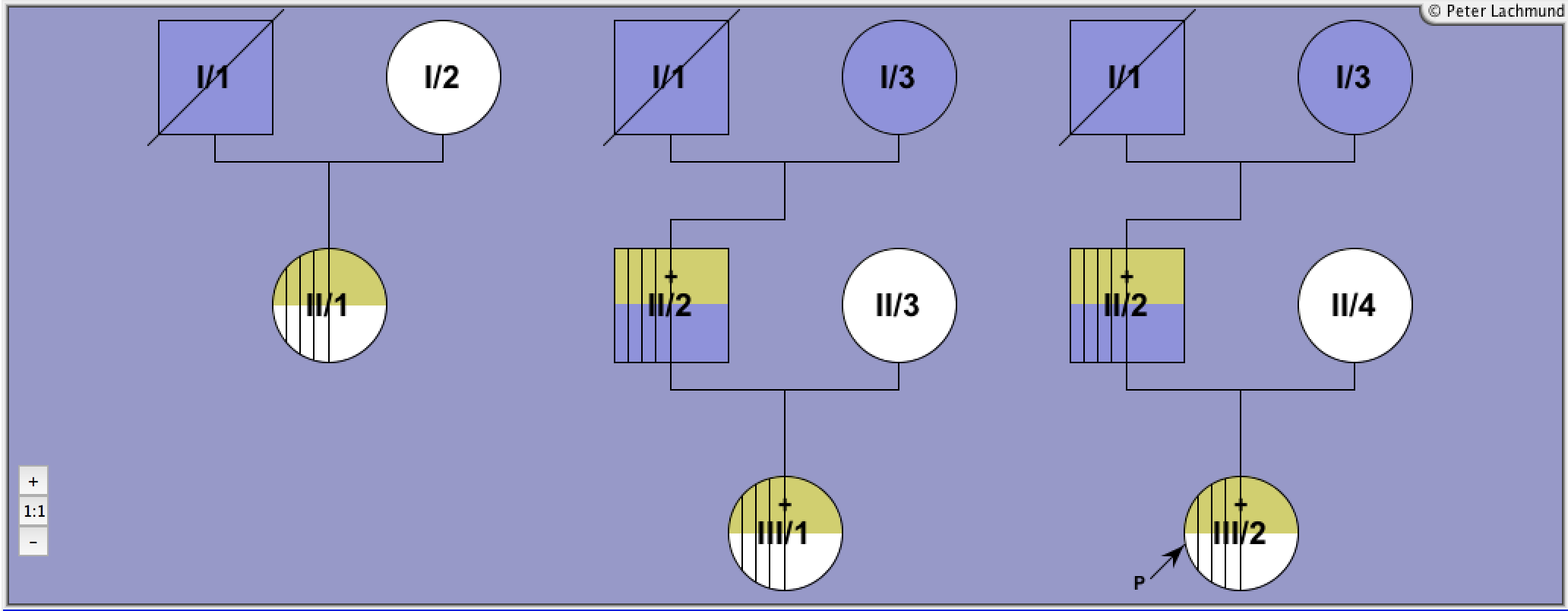Details Of Published TSH Receptor Mutation
Val 597 Phe
c.1789G>TConstitutively Activating TSH Receptor Mutation
Type
gain
Manifestation
family
Exon
10
Legend:

Male

Female

Unknown

Deceased
+
Mutation
-
No Mutation

Hyperthyroidism
(Heterozygous)
(Heterozygous)

Goiter

Relapse
P
Index Patient
Molecular Characteristics:
4 affected family members, 4 f, 1m in 2 generations
Note:
Blue marked individuals are identical (I/1, II/2 are married twice)
Caron et al: HCG hypersensitivity in familial gestational hyperthyroidism
Note:
Blue marked individuals are identical (I/1, II/2 are married twice)
Caron et al: HCG hypersensitivity in familial gestational hyperthyroidism
Clinical Features:
diagnosis:
III/2: 5yr (index patient)
III/1: 7yr
II/1: 15yr
II/2: 18yr
goiter in all patients
III/2,1, II/2: heterozygous for V597F
II/1: sample not available
* based on 1 hot nodule investigated by Paloz-Paz et al. 2008
and on 2 activating familial germline mutation investigated by Alberti et al. 2001 and Caron et al 2020
III/2: 5yr (index patient)
III/1: 7yr
II/1: 15yr
II/2: 18yr
goiter in all patients
III/2,1, II/2: heterozygous for V597F
II/1: sample not available
* based on 1 hot nodule investigated by Paloz-Paz et al. 2008
and on 2 activating familial germline mutation investigated by Alberti et al. 2001 and Caron et al 2020
Treatment:
III/2: antithyroid medication
III/1: TE at 9yr
II/1: TE at 16yr
II/2: TE at 18yr
III/1: TE at 9yr
II/1: TE at 16yr
II/2: TE at 18yr
Functional Characteristics:
cAMP
(basal)
(basal)
cAMP
(TSH)
(TSH)
IP
(basal)
(basal)
IP
(TSH)
(TSH)
TSH-Binding
Cell Surface Expression
Prevalence
LRA
Ref
2.0-4.5
0.7-1.0
n.d.
n.d.
nd
0.3-0.4
2
24.3+/-4.3
1,2
Legend:
cAMP (basal): basal in vitro cAMP production of mutant over wild-type TSHR
cAMP (TSH): maximal in vitro cAMP production of mutant over wild-type TSHR
IP (basal): basal in vitro IP production of mutant over wild-type TSHR
IP (TSH): maximal in vitro IP production of mutant over wild-type TSHR
TSH-binding: maximal TSH-binding compared to the wild-type TSHR
Cell surface expression: cell surface expression of mutant compared to WT-TSHR
LRA: linear regression analysis (LRA) of constitutive activity as a function of TSHR expression determined by 125I-bTSH binding or FACS analysis compared to the wild-type TSHR
Prevalence: Prevalence of (somatic and germline) activating mutations*
Ref: Reference for functional characterization
Child: Found in children.
Reference 1:
Alberti et al.
Eur. J. Endocrinol. 145: 249-254
A novel germline mutation in the TSH receptor gene causes non-autoimmune autosomal dominant hyperthyroidism
2001
Reference 2:
Mueller et al.
Thyroid. 19(7):765-73
Cases of borderline in vitro constitutive thyrotropin receptor activity: how to decide whether a thyrotropin receptor mutation is constitutively active or not?
2009

